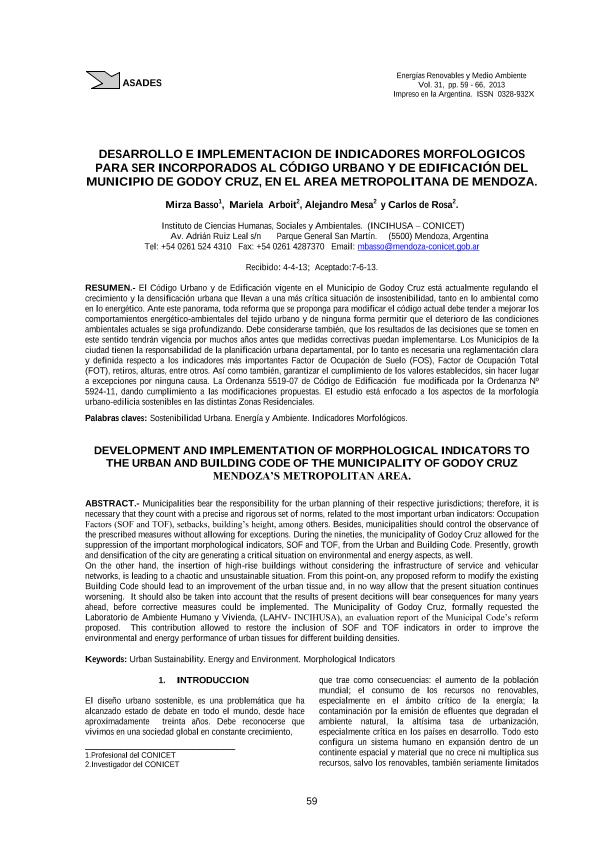Artículo
El Código Urbano y de Edificación vigente en el Municipio de Godoy Cruz está actualmente regulando el crecimiento y la densificación urbana que llevan a una más crítica situación de insostenibilidad, tanto en lo ambiental como en lo energético. Ante este panorama, toda reforma que se proponga para modificar el código actual debe tender a mejorar los comportamientos energético-ambientales del tejido urbano y de ninguna forma permitir que el deterioro de las condiciones ambientales actuales se siga profundizando. Debe considerarse también, que los resultados de las decisiones que se tomen en este sentido tendrán vigencia por muchos años antes que medidas correctivas puedan implementarse. Los Municipios de la ciudad tienen la responsabilidad de la planificación urbana departamental, por lo tanto es necesaria una reglamentación clara y definida respecto a los indicadores más importantes Factor de Ocupación de Suelo (FOS), Factor de Ocupación Total (FOT), retiros, alturas, entre otros. Así como también, garantizar el cumplimiento de los valores establecidos, sin hacer lugar a excepciones por ninguna causa. La Ordenanza 5519-07 de Código de Edificación fue modificada por la Ordenanza Nº 5924-11, dando cumplimiento a las modificaciones propuestas. El estudio está enfocado a los aspectos de la morfología urbano-edilicia sostenibles en las distintas Zonas Residenciales Municipalities bear the responsibility for the urban planning of their respective jurisdictions; therefore, it is necessary that they count with a precise and rigorous set of norms, related to the most important urban indicators: Occupation Factors (SOF and TOF), setbacks, building’s height, among others. Besides, municipalities should control the observance of the prescribed measures without allowing for exceptions. During the nineties, the municipality of Godoy Cruz allowed for the suppression of the important morphological indicators, SOF and TOF, from the Urban and Building Code. Presently, growth and densification of the city are generating a critical situation on environmental and energy aspects, as well. On the other hand, the insertion of high-rise buildings without considering the infrastructure of service and vehicular networks, is leading to a chaotic and unsustainable situation. From this point-on, any proposed reform to modify the existing Building Code should lead to an improvement of the urban tissue and, in no way allow that the present situation continues worsening. It should also be taken into account that the results of present decitions will bear consequences for many years ahead, before corrective measures could be implemented. The Municipality of Godoy Cruz, formally requested the Laboratorio de Ambiente Humano y Vivienda, (LAHV- INCIHUSA), an evaluation report of the Municipal Code’s reform proposed. This contribution allowed to restore the inclusion of SOF and TOF indicators in order to improve the environmental and energy performance of urban tissues for different building densities.
Desarrollo e implementación de indicadores morfologicos para ser incorporados al código urbano y de edificación del municipio de Godoy Cruz, en el área metropolitana de Mendoza
Título:
Development and implementarion of morphological indicators to the urban and building code of the municipality of Godoy Cruz Mendoza's metropolitan area
Fecha de publicación:
10/2013
Editorial:
Asociación Argentina de Energías Renovables y Ambiente
Revista:
Energías Renovables y Medio Ambiente
ISSN:
0328-932X
Idioma:
Español
Tipo de recurso:
Artículo publicado
Clasificación temática:
Resumen
Archivos asociados
Licencia
Identificadores
Colecciones
Articulos(INCIHUSA)
Articulos de INST. DE CS. HUMANAS, SOC. Y AMBIENTALES
Articulos de INST. DE CS. HUMANAS, SOC. Y AMBIENTALES
Citación
Basso, Mirza; Arboit, Mariela Edith; Mesa, Nestor Alejandro; de Rosa, Carlos; Desarrollo e implementación de indicadores morfologicos para ser incorporados al código urbano y de edificación del municipio de Godoy Cruz, en el área metropolitana de Mendoza; Asociación Argentina de Energías Renovables y Ambiente; Energías Renovables y Medio Ambiente; 31; 10-2013; 59-66
Compartir




